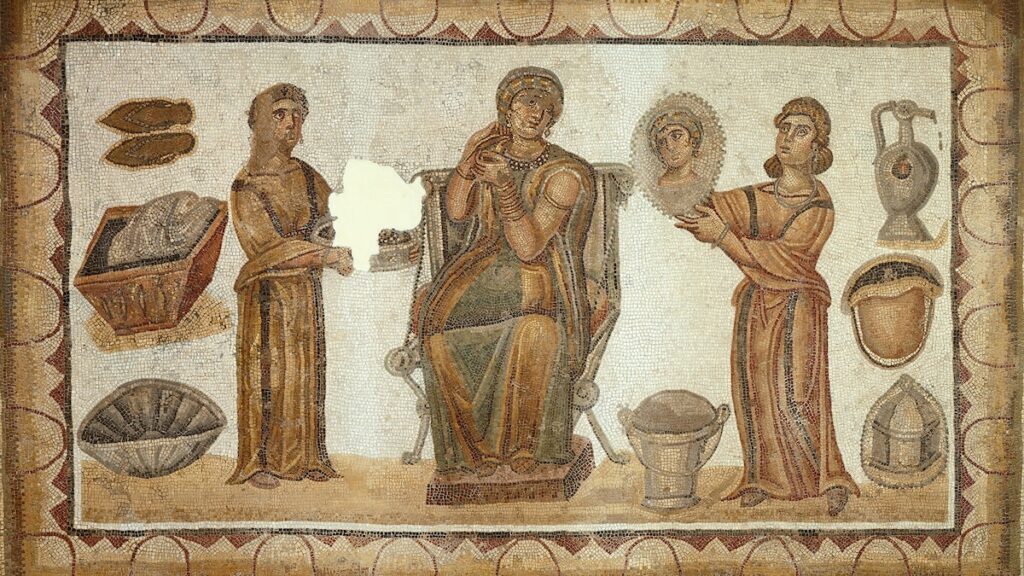Ancient toiletry sets. More than 50 tweezers. And most recently, a nail cleaner in Gloucestershire that dates back over 1,500 years. These are among the artifacts that archaeologists have unearthed in Britain dating back to when it was part of the Roman Empire.
Beginning with a Roman invasion in A.D. 43 and ending in the fifth century, this period marked an infusion of Roman culture into Britain. One of the Romans’ most notable cultural exports were their bathhouses and grooming habits, which spread throughout the Roman Empire’s other conquered territories, too.
(Blood and betrayal turned Rome from republic to empire.)
“It is these enormous municipal public baths that take these practices with them as they spread across the empire,” says Cameron Moffett, a curator at English Heritage. Tweezers, which Romans used to pluck unwanted body hair, “didn’t exist in Britain before the Romans arrived.”
Once the Romans invaded Britain, tweezers seemed to abound. These and other artifacts offer a painful peek into how Roman grooming tools and habits spread with the expansion of the Roman Empire after its founding in 27 B.C. While implements like tweezers are at least familiar to modern readers, others like strigils—the bronze tools Romans used to scrape their skin—may seem a bit more peculiar.
Nail care
Romans could clean and trim their nails (or have someone do this for them) at home, at the public baths, or—if they were men—at a barbershop. The Roman poet Horace, who lived during the first century B.C., wrote a line about “A close-shaven man, it’s said, in an empty barber’s / Booth, penknife in hand, quietly cleaning his nails.”
(We swapped baths for showers—but which is better for you?)
People in the city of Rome likely used knives or shears to tend to their nails, Moffett says. But interestingly, the nail cleaner unearthed in Gloucestershire that Oxford Cotswold Archaeology announced finding in May 2024 “is quite specific to this part of Britain,” says Alex Thomson, a project manager for the organization. This type of V-shaped nail cleaner (which could also serve as a file) only appears at Roman-era sites in Britain.
“No one knows quite why,” Moffett says, “but it was something that was developed in Britain, and so you simply do not get them on the continent.”
Body hair removal
One of the personal grooming fads in Rome during the empire, at least among wealthy elites, was body hair removal. Both men and women might pluck out their own unwanted hairs with tweezers, or have an attendant or enslaved person do so in their home or the public baths. However, not everyone approved of Romans paying such close attention to their appearance.
The philosopher Seneca, who lived in Rome during the first century A.D., complained in a letter about how noisy it was to live in lodgings overlooking a bathhouse. “Besides those who just have loud voices,” he wrote, “imagine the skinny armpit-hair plucker whose cries are shrill so as to draw people’s attention and never stop except when he’s doing his job and making someone else shriek for him.”
(Ancient Romans lost these gemstones down a bathhouse drain.)
It’s hard for us to know how widespread armpit hair plucking actually was from Seneca’s letter, says Jerry Toner, director of studies in classics at Churchill College, since this grooming habit appears to be part of a larger issue the philosopher had with contemporary Romans.
“He’s a big moralist, and he’s obviously condemning all this softness and luxury and leisure that’s going on in the bathhouse,” Toner says. “So he’s kind of hamming it up a bit, you know—all these people screaming at being plucked. But it definitely goes on reasonably commonly.”
Skin scraping
The strigil was a cleaning tool (often made of bronze) that the Romans adopted from the Greeks. At public baths, Roman men and women cleaned themselves by covering their bodies with oil that they then scraped off with a strigil, along with any dirt and sweat on their skin. Romans might first exercise in the bath complexes’ open courtyards before cleaning with the strigil, in order to build up a sweat.
Archaeologists have discovered “toiletry sets” in which strigils are connected to oil containers, and they’ve even found strigils buried in graves in the city of Rome and in Bulgaria, where the Roman Empire’s eastern borders extended. The third-century A.D. Bulgarian grave contained a unique vessel shaped like a man’s head that the owner may have used to carry oil to scrape off with the strigil.
It’s not clear why strigils turn up in graves, but scholars do know there was an association between strigils and athleticism, since athletes used them to scrape their bodies after exercising. Because of this, archaeologists nicknamed a fourth-century B.C. grave in Rome containing four bodies and two strigils the “Tomb of the Athlete.”
(How Roman gladiators got ready to rumble.)
Ear cleaning
Are you nervous about putting Q-tips in your ears? Well, Romans had it even worse. Archaeologists have discovered many tools known as “ear picks” or “ear scoops,” so-named because scholars theorize that Romans used them to clean wax out of their ears. These tools had a pick on one side and a tiny spoon or scoop on the other, and could be made of bronze, bone, or even glass.
These picks and scoops could have been multiuse tools that Romans used for more than just cleaning their ears. For example, Moffett suggests Romans might have used them to scoop out oil and perfume from small bottles.
Archaeologists often discover Roman tools like tweezers, nail cleaners, and ear picks or scoops connected together like a ring of keys, suggesting their shared status as toiletry and grooming items. The perfect accessory for the Roman guy or gal on the go.
>>> Read full article>>>
Copyright for syndicated content belongs to the linked Source : National Geographic – https://www.nationalgeographic.com/history/article/roman-empire-body-grooming
